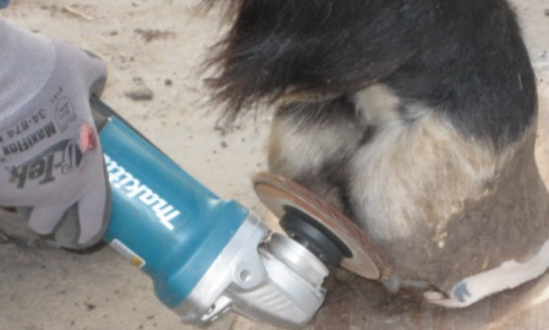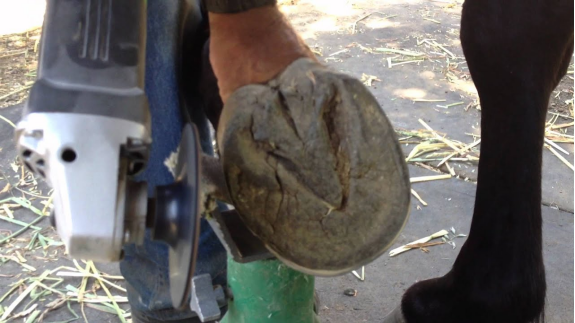Trimming a horse’s hooves is a crucial aspect of equine care, ensuring the health and comfort of these magnificent creatures. While traditional tools like farrier rasps have been the norm for hoof maintenance, modern technology offers a more efficient alternative: the angle grinder. An angle grinder, equipped with a suitable grinding disc, can help horse owners and caretakers achieve precise and effective hoof trims. This article will provide a comprehensive guide on how to use an angle grinder to trim horse hooves, including selecting the right grit grinding disc for the task.
Benefits of Using an Angle Grinder for Hoof Trimming
Angle grinders offer several advantages over traditional methods of hoof trimming:
- Efficiency: Angle grinders operate at high speeds, allowing for quick and accurate material removal. This efficiency reduces the time spent on each hoof, minimizing stress for both the horse and the caretaker.
- Precision: The controlled grinding action of an angle grinder enables precise shaping and leveling of the hooves, which is especially important for maintaining a proper balance and weight distribution.
- Ease of Use:Angle grinders are relatively easy to handle, requiring minimal physical effort compared to traditional tools. This is particularly beneficial for caretakers dealing with multiple horses.
- Versatility: Different grinding discs can be used for various tasks, such as trimming, shaping, and smoothing hooves, providing versatility in hoof maintenance.
Selecting the Right Angle Grinder and Grinding Disc
Angle Grinder Selection: When choosing an angle grinder for hoof trimming, consider models with adjustable speed settings. A variable-speed grinder allows you to control the RPM (rotations per minute), enabling safer and more controlled trimming. Additionally, opt for a grinder with a comfortable grip and safety features to prevent accidental activation.
Grinding Disc Grit: The choice of grinding disc grit is critical for achieving the desired results. Grit refers to the coarseness of the abrasive particles on the disc’s surface. Lower grit numbers indicate coarser particles, while higher numbers signify finer particles.
- Coarse Grit (30-60):Coarse grit grinding discs are suitable for initial material removal, particularly if the hooves are significantly overgrown or irregular. They help in quickly shaping the hooves to a manageable size.
- Medium Grit (80-120): Medium gritgrinding discs are ideal for refining the shape and leveling the hooves. They provide a balance between material removal and precision.
- Fine Grit (150-220): Fine gritgrinding discs are used for finishing touches and smoothing the hooves’ surfaces. They create a polished appearance and reduce the risk of splintering.
Steps to Trim Horse Hooves Using an Angle Grinder
- Preparation:
Ensure the horse is calm and securely restrained. Ideally, have a knowledgeable handler assist you during the process.
Have all necessary safety gear, including eye protection, ear protection, and sturdy gloves.
Position the horse in a well-lit and clean area with minimal distractions.
- Choose the Right Disc:
Based on the hoof’s condition, select an appropriate grit grinding disc for the initial trimming. Coarser grits are suitable for overgrown hooves, while finer grits work for maintenance trims.
- Introduce the Grinder:
Before turning on the grinder, allow the horse to become familiar with its sound and vibrations. Gently touch the grinder to the horse’s body so that they can feel the vibrations without the noise.
- Start Grinding:
Begin grinding the hoof at a slow speed, working from the bottom towards the top. Hold the grinder at a slight angle to prevent gouging the hooves.
- Maintain Control:
Keep a steady hand and apply consistent pressure. Avoid sudden movements that could startle the horse or compromise the quality of the trim.
- Trimming Technique:
Use the grinder to shape the hooves while maintaining a natural angle. Aim for an even sole, balanced heels, and a proper toe length.
- Check Progress:
Frequently stop and evaluate the hoof’s progress. Compare it to the other hooves to ensure uniformity.
- Switch Grits (if necessary):
If you started with a coarse grit grinding disc, switch to a medium grit grinding disc for refining the shape and ensuring a smoother finish.
- Final Touches:
If using a fine grit disc, complete the trimming process by smoothing the hooves’ surfaces. This step ensures the hooves are less likely to splinter or crack.
Safety Measures
- Safety Gear: Always wear appropriate safety gear, including safety goggles, ear protection, and gloves, to protect yourself from debris and noise.
- Horse Safety: Ensure the horse is calm and properly restrained. Have a handler present who is familiar with the horse’s behavior.
- Proper Technique: Maintain a firm grip on the grinder, using controlled movements. Avoid excessive pressure or sudden motions that could startle the horse.
- Avoid Overheating: Allow the grinder to cool down if it becomes too hot to touch, as overheating can damage the tool or cause injuries.
Conclusion
Using an angle grinder for trimming horse hooves can revolutionize the way caretakers maintain their equine companions’ hoof health. The efficiency, precision, and versatility of angle grinders, combined with the right grit grinding disc, can result in well-balanced and comfortable hooves. However, it’s crucial to approach this method with caution, prioritizing safety for both the horse and the operator. By following the steps outlined in this guide and employing the recommended safety measures, horse owners can confidently integrate the use of angle grinders into their hoof maintenance routines, contributing to the overall well-being of their beloved animals.


